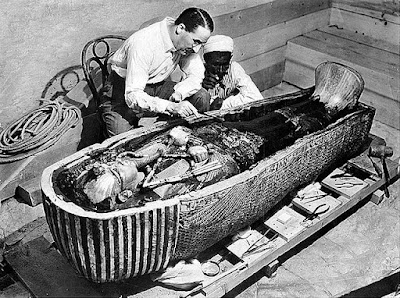Egyptian History Of Mystery Tutankhamun
Egyptian History Of Mystery Tutankhamun
Tutankhamun, also known as Tutankhaten or Tutankhuaten, was an ancient Egyptian pharaoh who lived around 3,300 years ago, from approximately c. 1341 BC - c. 1323 BC. He belonged to the Eighteenth Dynasty of Egypt, and his reign marked the end of this royal line.
Tutankhamun became pharaoh at a very young age, around nine years old, and ruled until his untimely death at about nineteen. One of the most significant actions of his reign was the reversal of religious and political changes introduced by his predecessor, Akhenaten, during a period known as the Amarna Period. Tutankhamun restored the traditional polytheistic form of ancient Egyptian religion, undoing the religious shift known as Atenism. He also relocated the royal court away from Akhenaten's capital, Amarna, to reestablish stability.
Interestingly, Tutankhamun was one of the few pharaohs in history to be worshipped as a deity while still alive, a practice typically reserved for posthumous honors. Today, he is widely recognized for the immense wealth discovered in his tomb, known as KV62, which was found in nearly perfect condition in 1922. This discovery is considered one of the most significant archaeological findings of all time, and Tutankhamun is often colloquially referred to as "King Tut."
Tutankhamun's rise to power occurred during a turbulent period in Egyptian history. Akhenaten's introduction of Atenism had caused widespread instability, and Tutankhamun's older half-brother, Smenkhare, had a brief reign, as did Neferneferuaten, likely Smenkhare's widow and possibly Meritaten. Tutankhamun took the throne under these challenging circumstances and worked to reverse Atenism through extensive religious and cultural reforms, as evidenced by artifacts like the Restoration Stela. He reinstated the traditional worship of the god Amun and changed his own name from Tutankhaten to Tutankhamun. His wife, Ankhesenpaaten, also adjusted her name to Ankhesenamun in accordance with these changes.
Following Tutankhamun's premature death after ten years of rule, his vizier, Ay, who may have been his granduncle, assumed the throne, likely marrying Ankhesenamun. This was despite Tutankhamun having designated his commander-in-chief, Horemheb, as his heir. Ay's reign was brief, and Horemheb succeeded him, possibly briefly marrying Ankhesenamun before her early death a few years into Horemheb's lengthy rule. Horemheb secured the throne due to the death of Ay's designated heir, generalissimo Nakhtmin. Horemheb took significant steps to restore the traditional ancient Egyptian religion and stabilize the nation. Eventually, he chose Ramesses I, a civilian-military officer, as his heir, who had a grandson named Ramesses II, the third pharaoh of the Nineteenth dynasty.
What makes King Tutankhamun so renowned?
Well, it's because his tomb, unlike any other royal tomb in the Valley of the Kings, was unearthed in almost pristine condition. Inside, they discovered the mummified king resting within a series of golden coffins, with over 5,000 priceless treasures and artifacts filling the tomb. This incredible find was completely unprecedented in its scale and opulence.
What do we know about Tutankhamun's parentage?
Well, DNA testing conducted in 2010 has yielded compelling evidence indicating that Tutankhamun's father was probably Pharaoh Akhenaten, who introduced an early version of monotheism. identified his father as the mummy within tomb KV55
Additionally, this testing revealed a significant revelation: Tutankhamun's mother was, in fact, Akhenaten's sister. His mother was identified as a mummy from tomb KV35.
 |
| Tutankhamun's family tree |








It was a usefull information. please continue posting these kind of information
ReplyDelete